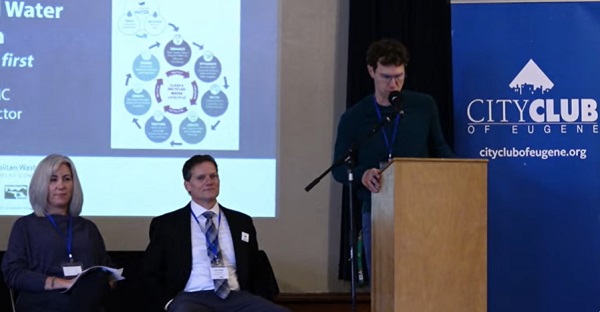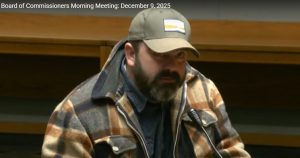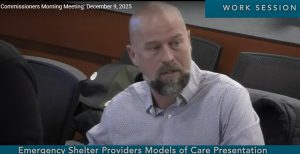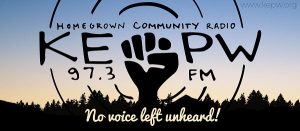EWEB: Water banked in storage system will feed hydrants during wildfire
13 min read
Presenter: In a wildfire, could our hydrants run dry here in Eugene and Springfield, as they did in LA? Experts on our water infrastructure took questions at City Club Jan. 10.
Jerry Smith (City Club member): Jerry Smith, City Club member here in Eugene. With the wildfires in Los Angeles, they were caught with not enough water, that actually the hydrants went dry and it remains that way. Have we any backup? Certainly late fall, here, we’re a threatened community every year and do we need more resources in terms of saved water?
[00:00:40] Presenter: Karen Kelley.
[00:00:41] Karen Kelley (EWEB): I’m Karen Kelley. I’m the chief operations officer for the Eugene Water and Electric Board… EWEB is highly concerned about fire impacts. We do have some high-risk fire zones for our electric customers upriver certainly, but also in South Eugene we have another area that’s considered a high-risk fire zone.
[00:00:59] With drinking water, we are required to meet fire flow protection standards and that is where a lot of the water in our storage system is basically banked, is to meet those standards. And our pumping systems must be able to move that water to those areas in order to meet the standards that have been set.
[00:01:18] We do meet the standards. That is not to say that we shouldn’t have more backup supplies ready to go and working with the fire department to make sure we can haul water to areas that maybe we need it. Certainly a big concern for us.
[00:01:33] Presenter: With more about EWEB’s attention to water supply and water quality, Karen Kelley:
[00:01:38] Karen Kelley (EWEB): My history comes from public health. I started out working for Linn County Environmental Health and the Oregon Health Authority as an environmental health regulator.
And while I worked for the state, I was part of numerous incidents of investigating and resolving waterborne disease outbreaks as well as assisting water utilities when their single source of drinking water was disrupted or ran dry: Think contamination, equipment failures, major leaks, and drought. The consequences of those are severe.
[00:02:06] One of the stories that got my attention in 2014 happened to a utility in West Virginia when about 10,000 gallons of chemicals, a couple of really bad chemicals, leaked into their single source of drinking water, which was the Elk River. This forced this community to issue a ‘Do Not Use’ order. So not a boil order where you can still actually use the water, but ‘Do Not Use,’ meaning it cannot come in contact with your skin—or anything, essentially. You can use it to flush toilets and that’s about it.
[00:02:34] In total, that spill affected about 300,000 people, 369 of which went to the hospital with health effects. The order lasted only five days, which is, you know, tough, but not insurmountable. But what happened really in reality was that the public’s trust was lost, not just for a short period of time, but really years, in their water system.
[00:02:56] And we don’t have to look far for other examples of water crises. In 2018, the city of Salem had to issue a ‘Do Not Use’ order because of cyanotoxin contamination in the water. That had resulted from harmful algal blooms in their North Santiam watershed. That’s their primary water source and their treatment system was not designed to handle or adequately remove that contamination.
[00:03:19] Their backup wells, which they did have many of these, they did not have enough capacity to meet the needs of the city. The order lasted over a month and had a huge impact on residents and the local economy. It resulted in the governor issuing a state of emergency.
[00:03:33] Just this fall, the city of Asheville, North Carolina experienced a hurricane that totally devastated their water system, leaving residents without usable tap water for nearly two months. So imagine—52 days without access to clean drinking water in their home. And this was a city much like Eugene that is considered a climate safe haven. But just like the West Virginia example, Salem and Asheville, we have the same climate risks and water system vulnerabilities that we must prepare for.
[00:04:02] And I have to tell you, I’ve never been so stressed in my life as I was during the Holiday Farm Fire of 2020. The evacuation zone was right across the river from our one and only treatment plant and we had many sleepless nights wondering if we were going to have to evacuate and: What would we do should we lose this water plant? What would our community do?
[00:04:21] Presenter: Those solutions are well underway. At the City Club Jan. 10, EWEB’s Karen Kelley:
[00:04:27] Karen Kelley (EWEB): Our current focus is on building robust water storage facilities, which are the backbone to our distribution system. We installed two new tanks at our East 40th Avenue site and are now working on building earthquake-resilient water storage tanks at College Hill and eventually at Hawkins Hill. And given that you are all very engaged community members, I’m sure you’ve heard a lot about these projects and seen them in the news.
[00:04:50] In addition, we are finishing up a multiyear project to bring emergency water stations fed by wells to the city of Eugene. We have seven sites, one is still under construction, and these provide water that’s for domestic use. So people have to physically get to these sites, have containers that they fill up, and bring those back to their home.
[00:05:10] But this is critical for us, should we experience a major earthquake or a long water outage, because this will keep folks living. And that’s how serious this kind of situation actually is, because if we were to have a major earthquake, our pipelines, all 800 miles of it, are not completely seismically robust. There’s no way for us to make that happen overnight. So we continue to work on that, but these stations are critical for us.
[00:05:35] We are also moving forward on the largest and most impactful resiliency project in recent history for EWEB, establishing a second source of water by building a new water treatment plant on the Willamette River. Of the 20 largest cities in the Pacific Northwest, Eugene is the only one with a single source of drinking water.
[00:05:54] Given that we only have one to two days of water supply in the system during peak usage months, that puts us at high risk should we have a major event such as critical equipment failure, hazardous material spill into the river, or a natural disaster.
[00:06:08] It also impacts our operations in parts of the plant that are difficult, even impossible in some cases, to take offline for maintenance and repair. That is a primary concern for me personally.
[00:06:20] For us, the answer is diversifying our water sources. That’s the single most important thing we can do for our resiliency. EWEB would like to be more self-sufficient in times of crisis and be able to support others in the region if needed.
[00:06:33] In other words, we would like to be an asset rather than a liability in the community. And we have found a workable solution to diversify our water supply on the Willamette River at an intake where the quality is excellent. The location is upstream of urban areas at the confluence of the Coast and Middle Fork, near Mount Pisgah and Dorris Ranch.
[00:06:53] There is a newly-established confluence preserve just before the river reaches the intake site, which will help filter naturally and enhance the water quality through protected natural habitat and floodplain areas.
[00:07:05] You’ve heard the old adage, ‘An ounce of prevention is worth a pound of cure?’ Well, that’s what we’re doing here. We’re looking at what are the potential contaminant sources in the watershed and what could we do to mitigate or reduce their impacts on drinking water quality.
[00:07:21] If we can keep it out of the river or reduce the impacts, we can prevent costly changes to our treatment system while improving the health of the river for ecology, recreation, and other interests.
[00:07:33] This is no easy task given that we don’t own or manage much of the property within the watershed. This is why it’s so important that we have partnerships with other agencies and interested parties throughout the watershed. We’ve implemented many mitigation efforts over the last couple of decades and we look forward to strategizing on protection measures for the Willamette much in the same way as we have with the McKenzie.
[00:07:56] For water quality, the McKenzie and the Willamette are both excellent sources of water. EWEB has been testing samples from the Willamette near the new intake for the last 10 years, and we have not detected levels of concern for over 250 regulated health contaminants, including pesticides, pharmaceuticals, PFAS, and others.
[00:08:16] PFAS is one of the hot topics here recently in the world of drinking water. It’s a compound that makes materials fireproof and also non-stick, and those have been showing up in drinking water samples. We have not found that in the Willamette.
[00:08:32] The sources are also remarkably similar in parameters that have the greatest impact on taste and odor as well. That is a big interest, of course, to anyone who’s drinking water, but also to some of the folks who are producing things, industries, I’m thinking of our breweries that we’re so fond of here in Eugene, that have a high interest in what’s this new water going to do, how will it taste, will it change my product.
[00:08:55] So there are some swings in the organic material in the Willamette that we don’t see so much in the McKenzie, but that can be managed through treatment.
[00:09:03] So how, through the treatment process, are we going to make the water better? Especially if there are some differences. Well, the Hayden Bridge filtration plant currently uses a three-step process: clarification, filtration, and disinfection that we follow up with pH adjustment to ensure that the water is not corrosive to pipes and plumbing.
[00:09:22] The new plant will take advantage of modern equipment and processes to improve on these basic steps and add a fourth treatment option to the process called ozone. Ozone adds another layer of safety and a barrier to contamination to the treatment process, and together with the granulated-activated carbon caps that we’ll have on our filtration, we can treat the more difficult compounds that traditional treatment processes were never designed for.
[00:09:48] We are planning to go out for bid on the plant design in the next month or so and hope to award the job in April or May of this year. Construction won’t begin until 2026 at the earliest, and it’s going to take about three years to complete. So by 2029, we hope to commission the plant and introduce Willamette water into the system.
[00:10:07] We are projecting the cost of this plant to be about $100 million. Of the 8% increase in water rates this year, 2.5% are attributed to the new plant. Eight percent means about a $3 a month increase in your water bills, and that’s for an average residential customer.
[00:10:27] However, that still puts us as second-lowest in water rates amongst our comparators. We haven’t moved in many years. We’ve been down at the bottom, which is good news for us. We want to keep our rates low, and we do take rate impacts and affordability very seriously.
[00:10:42] Doug Bovee: I’m Doug Bovee from Springfield now, formerly from Eugene, so interested in the connection and overlap and I have a fundamental question. I don’t understand why drought and what is drought?
[00:10:57] Presenter: Todd Miller.
[00:10:58] Todd Miller (Metropolitan Wastewater Management Commission): When we have drought here, the declared droughts we’ve had in Lane County, it’s because we’ve had abnormally low amounts of water, reduced snowpack, reduced runoff, reduced groundwater storage that is releasing that water to our rivers and provides less water all the way around.
[00:11:15] You know, pretty much I think across Oregon with water rights, over 100% of that water is really allocated. There’s already people that have dibs on that water. So when that water supply goes down, it’s not what it has been historically. And then that’s a drought situation for us. Somebody is going without water.
[00:11:31] And particularly with habitat, the different species need water and have historically evolved with certain volumes of water and qualities of water at certain times of year. When that system gets perturbed and doesn’t have the same amount of water at the same times that we used to, that’s a drought impact.
[00:11:50] Presenter: From EWEB, Karen Kelley:
[00:11:52] Karen Kelley (EWEB): I would just want to add that we are very fortunate here on the McKenzie that the geology is such that it is mostly snowpack that is feeding it. The water gets into our groundwater supply up in, if you know where Clear Lake is, way up there, there’s a bunch of springs that feed the McKenzie River, and that water has been underground for about seven years before it comes out as flow to the McKenzie.
[00:12:15] So when we have watched drought from a drinking water perspective, 2015 was a significant year for us, we did find that the base flows in the McKenzie stayed very steady. So drought is certainly a concern. We want to maintain stewardship and be conserving water during a drought. But I’m also feeling pretty comfortable that that base flow is going to sustain our needs for the immediate future.
[00:12:41] Wendy Wheeler-Coltrane (City Club): My name is Wendy Wheeler-Coltrane. Many years ago I was told that the McKenzie River was the third-purest water source in the world. Where do we stand with the McKenzie now in terms of its purity—how does it stand in comparison to the Willamette?
[00:13:00] Presenter: EWEB’s Karen Kelley.
[00:13:01] Karen Kelley (EWEB): So when we look at the health-based constituents, they’re very, very similar. Excellent quality…
[00:13:08] As with any surface water body, we have to meet the health standards, and that does require certain processes to meet the Safe Drinking Water Act requirements.
[00:13:16] The new plant on the Willamette is, like I mentioned, going to be much the same in terms of the basic treatment processes, but we are adding additional barriers to contamination to deal with any new types of contaminants that come our way.
[00:13:31] And there have been many in recent years. Some that I didn’t mention are pharmaceuticals, personal care products, endocrine disruptors. Those are things that we never looked for before. They’re not new. But we never looked for them before. And then when you look for them, you may find them.
[00:13:45] And what we’re finding is that they do have health implications on people in long-term consumption settings.
[00:13:51] So this new plant, we’re planning for that. There is a difference in the types of contaminant sources within the watersheds.
[00:13:59] At the Hayden Bridge filtration plant, we do have ability to treat for cyanotoxins. We turn that ability on when we have a problem. So our monitoring systems up throughout the watershed give us an early warning sign that we might have a problem. So we can treat for that there.
[00:14:16] But at the new plant, it’s going to be operating full-time, all of the time, so we’re just planning for the future. These are things that people didn’t think about a couple of decades ago. In fact, I didn’t either. When I first started (this is my 29th year in my career), folks were just beginning to look for lead in drinking water. So things do evolve over time, and we’re trying to evolve with it.
[00:14:38] Curt Yider (City Club): Hi. I’m Curt Yider. I read that the incoming federal administration is interested in cutting a couple trillion dollars out of the budgets. Since your projects are several years in the making, are they at risk?
[00:14:52] Presenter: Karen Kelley:
[00:14:52] Karen Kelley (EWEB): I would say I don’t have a crystal ball so I always plan for the worst and hope for the best. So our funding has been secured through rates. Our planning is in the rates. You know there’s still a chance that some other economic driver may make us change our mind. We’re fully in the throes already on our project, so I find that difficult to see happen for us here, but nothing is 100%. I’m definitely hopeful that that does not happen. I think most folks do understand the importance of clean, safe drinking water, including the new administration, but time will tell.
[00:15:28] Presenter: At the City Club, Mary Leighton:
[00:15:30] Mary Leighton (City Club): This school year, Network Charter School kids are sampling the water in the Willamette River and learning how, at Alton Baker Park, and learning how to evaluate water safety. We heard a little bit about your path through public health, but what I’m interested in is if a kid is captivated by the notion of preserving water, what are the steps out of high school they might take, both, not just the college-driven but the trade-driven, what direction might they take next that would lead in the direction to be good waterkeepers?
[00:16:01] Karen Kelley (EWEB): I’m always happy to hear that folks have an interest. We do also put on some job fairs from time to time so I would keep looking at our website. Our communications group does let folks know when we’re doing things like that. For example, you can have a GED all the way up to a PhD and work somewhere in EWEB.
[00:16:20] In the water world, we have seen a downsizing of the community colleges taking interest in keeping the programs going. It has been a disappointment to us, but any kind of science-based program would get you on the right path. Engineering is another great avenue to go, but you know, feel free to reach out. If you’ve got somebody who’s interested, we can connect you.
[00:16:41] Presenter: EWEB Chief Operating Officer Karen Kelley expressed confidence that local hydrants would not go dry, even during a drought year. EWEB’s new $100 million treatment plant goes out for bid next month. It will be able to detect new and emerging public health threats in our drinking water.



